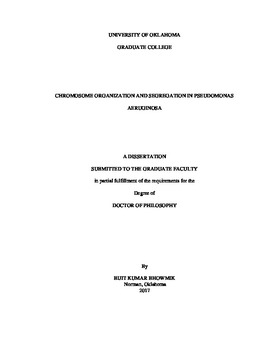| dc.contributor.advisor | Rybenkov, Valentin V. | |
| dc.contributor.author | Bhowmik, Bijit Kumar | |
| dc.date.accessioned | 2017-12-16T02:30:53Z | |
| dc.date.available | 2017-12-16T02:30:53Z | |
| dc.date.issued | 2017-12 | |
| dc.identifier.uri | https://hdl.handle.net/11244/52950 | |
| dc.description.abstract | The faithful propagation of genetic information from a mother to its progeny is one of the most fundamental aspects of life. Encoding the entirety of an organisms' genetic information onto chromosomes poses a unique set of problems that cells are required to overcome for proper genetic flow. In bacteria, one or more DNA molecules are condensed almost 1000-fold in order to fit within the small vicinity of a single cell. While undergoing significant compaction, the chromosome must also retain its accessibility in order to perform various DNA dependent processes. Although several key elements of chromosome organization have been identified, our knowledge regarding this process remains limited. In order to maintain genetic integrity, newly replicated chromosomes must faithfully segregate into daughter cells before the completion of cell division. Unlike in eukaryotes, chromosome replication and segregation in bacteria occur concurrently. How a bacterial chromosome maintains coordination between replication, segregation, and cell division is still unclear. The role of chromosome organization in segregation is also not fully understood. Therefore, it is of the utmost importance to acquire a better understanding of these complex biological processes which will in-turn illuminate our comprehension of the most basic and fundamental aspects of life. Elucidation of such processes will enable the potential to better manipulate chromosomes which can have various applications including but not limited to anti-microbial drug discovery, anti-cancer therapy, and creating programmable artificial cells. | en_US |
| dc.description.abstract | This study investigated chromosome segregation in an opportunistic human pathogen, Pseudomonas aeruginosa. Pseudomonas related infections are one of the major causes of death in newly born babies, burn victims, cystic fibrosis patients, and patients with suppressed immune system. The ability of this organism to differentiate into different morphological states allows it to survive in various ecological niches. Its intrinsic multi-drug resistance and ability to form biofilms make it difficult to control. With the emergence of multi-drug resistant strains of Pseudomonas aeruginosa, the discovery of new drugs is imperative in order to prevent further transmission of this organism. A better understanding of chromosome dynamics can help identify and exploit novel drug targets. | |
| dc.description.abstract | To determine the segregation pattern in the P. aeruginosa strain PAO1, a fluorescent repressor-operator system was used. The data indicate that the PAO1 chromosome is longitudinally organized between the origin of replication site, oriC to the sister chromosome resolution site, dif. In PAO1, both replication and segregation initiate at oriC and progress bidirectionally. Interestingly, chromosome segregation but not replication ends at the dif site. Proteins of the condensin family play a major role in global chromosome organization in both prokaryotes and eukaryotes. In Pseudomonas aeruginosa, two different families of condensins are present: MksBEF and SMC-ScpAB. These two proteins localize on different regions of the chromosome and differentially affect chromosome segregation. Finally, the study uncovered a novel co-ordination between condensin mediated global chromosome organization and ParABS mediated chromosome segregation, where the presence of at least one of them is necessary for cell viability. | |
| dc.language | en_US | en_US |
| dc.subject | Pseudomonas aeruginosa | en_US |
| dc.subject | Two condensins | en_US |
| dc.subject | Asymmetric chromosome | en_US |
| dc.subject | Chromosome segregation | en_US |
| dc.subject | ParB | en_US |
| dc.subject | Synthetic lethality | en_US |
| dc.title | Chromosome Organization and Segregation in Pseudomonas Aeruginosa | en_US |
| dc.contributor.committeeMember | Zgurskaya, Elena | |
| dc.contributor.committeeMember | Rajan, Rakhi | |
| dc.contributor.committeeMember | Bourne, Christina | |
| dc.contributor.committeeMember | Libault, Marc | |
| dc.date.manuscript | 2017-12 | |
| dc.thesis.degree | Dr.P.H | en_US |
| ou.group | College of Arts and Sciences::Department of Chemistry and Biochemistry | en_US |
| shareok.nativefileaccess | restricted | en_US |
